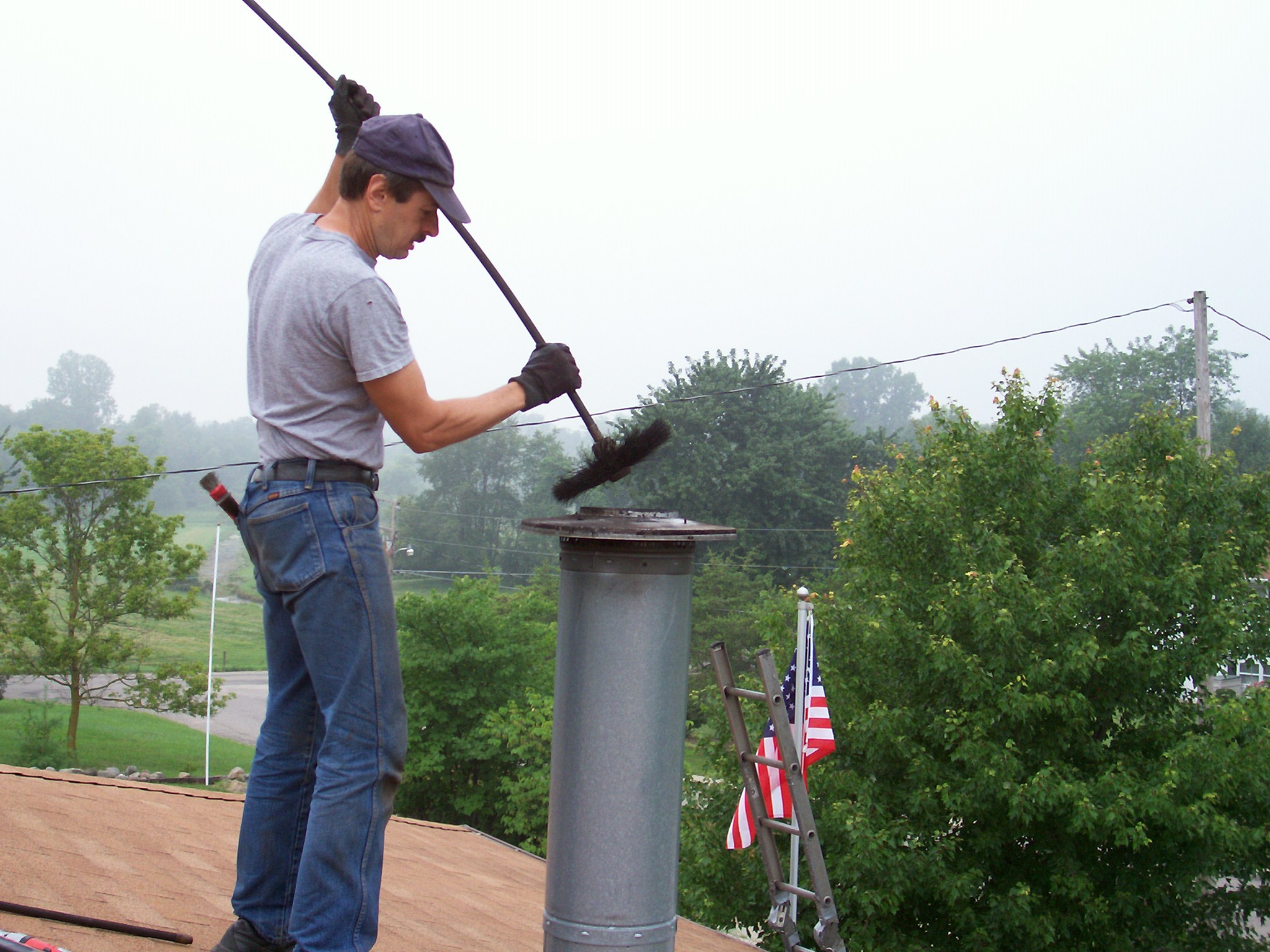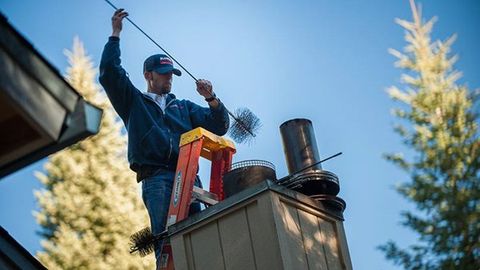Very Best Chimney Clean Company Fremont: Your Companion for a Cleanser, Safer Home
Very Best Chimney Clean Company Fremont: Your Companion for a Cleanser, Safer Home
Blog Article
Why Routine Smokeshaft Cleaning Is Necessary for Home Safety And Security
Regular chimney cleaning is a typically forgotten yet crucial facet of keeping a safe and secure and safe home environment. While it may not be the most exciting or glamorous task on your to-do listing, ignoring smokeshaft upkeep can have significant consequences. The accumulation of soot and creosote in your chimney can position a considerable fire threat, while inadequate air flow can bring about the potentially deadly risks of carbon monoxide poisoning. Routine chimney cleaning can help expand the life expectancy of your smokeshaft, saving you from expensive repair work or substitutes down the line. Yet just how precisely does chimney cleaning add to home safety and security? Let's discover the reasons behind this important maintenance job and uncover the ideas for appropriate chimney treatment that every house owner must understand.
Importance of Routine Smokeshaft Cleaning
Normal chimney cleansing is essential for keeping a safe and reliable home environment. In time, creosote, a very flammable compound, accumulates inside the chimney (Chimney Clean Company Fremont). This deposit is a result of burning timber and can accumulate on the inner wall surfaces of the smokeshaft. It can posture a major fire danger if left unchecked. Regular cleaning eliminates this creosote build-up and reduces the risk of chimney fires.
Along with protecting against fires, normal smokeshaft cleaning additionally ensures the effective procedure of your heating unit. When creosote collects, it restricts the air flow via the smokeshaft, leading to poor combustion and decreased heating efficiency. This can result in higher energy bills as your heating system functions harder to keep the wanted temperature level. By routinely cleansing the smokeshaft, you can maximize the air flow and make best use of the performance of your home heating system.
Moreover, a tidy chimney advertises great interior air high quality. As the smokeshaft ends up being clogged with creosote and particles, it can hinder the appropriate venting of dangerous gases, such as carbon monoxide.
Fire Risk: Buildup of Soot and Creosote
The buildup of soot and creosote inside the chimney positions a substantial fire hazard, as it can fire up and trigger a potentially devastating chimney fire. It consists of fine bits that can quickly end up being air-borne and clear up inside the smokeshaft. It is a by-product of insufficient combustion and can adhere to the inner walls of the chimney.
Both soot and creosote are highly combustible. When a fire is lit in the fireplace or stove, the heat and flames rise the smokeshaft. These substances can ignite and develop a smokeshaft fire if there is a significant buildup of residue or creosote. The extreme warm produced during a smokeshaft fire can create the chimney to crack or collapse, leading to a prospective residence fire. Furthermore, the flames and sparks from the smokeshaft fire can get away with the chimney cap and ignite the roofing system or bordering combustible materials.

Normal smokeshaft cleaning is necessary to eliminate the buildup of residue and creosote and minimize the risk of a smokeshaft fire. A specialist chimney sweeper will certainly utilize specialized brushes and devices to thoroughly clean up the chimney, getting rid of any type of accumulated debris. By keeping the smokeshaft complimentary and clean from residue and creosote, homeowners can make certain the safe and reliable operation of their fire place or oven, while also shielding their home from the risks of a smokeshaft fire.
Poor Air Flow and Carbon Monoxide Threats
Insufficient air flow in chimneys can present serious threats of carbon monoxide poisoning. Carbon monoxide gas (CARBON MONOXIDE) is a colorless, unsmelling gas that is created when gas such as gas, timber, or oil are shed. When smokeshafts are not correctly aerated, carbon monoxide can accumulate and permeate into the living areas of a home, bring about potentially serious circumstances.
Among the major reasons for bad smokeshaft air flow is the accumulation of debris, such as residue and creosote, which can obstruct the flue and restrict the flow of air. This can lead to insufficient burning and the production of higher levels of CO. Additionally, a chimney that is sporadically cleaned can have an accumulation of various other blockages, like bird nests or leaves, further hampering the correct ventilation of hazardous gases.
The results of carbon monoxide poisoning can be refined and quickly mistaken for other health problems, such as the flu. Signs may consist of migraines, wooziness, confusion, fatigue, and queasiness. Prolonged exposure to high levels of carbon monoxide can lead to unconsciousness, body organ damages, and also fatality.
Routine chimney cleaning and inspection are essential in maintaining proper air flow and lowering the threat of carbon monoxide gas poisoning. By eliminating any type click for more info of obstructions and ensuring that the flue is clear, homeowners can enjoy a healthy and balanced and secure living setting. It is suggested to have smokeshafts inspected and cleansed at the visit site very least when a year by a professional chimney sweep to ensure optimal security and tranquility of mind.
Prolonging the Lifespan of Your Chimney
To make sure the durability of your chimney, proper maintenance and care are vital. Routine smokeshaft cleaning is not only crucial for home security yet likewise for extending the life expectancy of your chimney. Gradually, creosote, residue, and particles can collect inside the chimney, causing various problems that can considerably lower its life expectancy.
One of the major advantages of regular smokeshaft cleaning is the prevention of chimney fires. If not gotten rid of, it can develop up inside the smokeshaft and ignite, causing a potentially destructive and unsafe smokeshaft fire.
Furthermore, regular chimney cleaning also helps to avoid obstructions. When particles, such as fallen leaves, branches, or also little pets' nests, obstruct the chimney, it can impede appropriate ventilation and airflow. This can result in an accumulation of damaging gases, such as carbon monoxide gas, inside the home. By keeping the chimney clean and clear, you can guarantee proper ventilation and decrease the danger of carbon monoxide poisoning.
In enhancement to avoiding fires and obstructions, normal smokeshaft cleansing can also determine and address any type of prospective damage or damage. By evaluating the chimney during the cleansing process, you can capture any type of early indicators of fractures, leaks, or architectural issues. Trigger repair services can be made to avoid further damages and extend the life-span of your chimney.
Tips for Proper Smokeshaft Maintenance
For reliable chimney upkeep, it is crucial to follow a couple of essential pointers to make sure the longevity and safety and security of your chimney. These ideas will not just help you preserve the performance of your chimney yet likewise lower the risk of smokeshaft fires and other prospective threats.
Firstly, it is crucial to have your chimney evaluated and cleaned by an expert chimney sweeper at least yearly. A professional will have the ability to determine any kind of possible problems such as creosote buildup, pet nests, or structural damage that might pose a danger to my website your smokeshaft's performance and safety and security.
Along with annual examinations, it is essential to regularly inspect and cleanse your smokeshaft's flue and cap. The flue needs to be clear of any debris or blockages that can limit airflow or cause smoke to back up into your home. The smokeshaft cap need to remain in excellent condition, securely attached, and totally free of any type of splits or damages to stop undesirable visitors such as birds or squirrels from entering your smokeshaft.
Furthermore, it is important to utilize dry and experienced wood for burning in your fireplace. Wet or green timber generates even more smoke and creosote, bring about a greater threat of smokeshaft fires. Furthermore, prevent shedding materials such as trash, cardboard, or treated wood, as they can launch dangerous chemicals and harm your chimney.
Finally, make certain that your chimney is geared up with a durable trigger arrestor to stop embers and triggers from getting away and potentially creating a fire. Chimney Clean Company Fremont.
Following these suggestions for appropriate chimney upkeep will aid make certain the safety and security and long life of your chimney and provide assurance for you and your family members.

Verdict
In final thought, regular smokeshaft cleansing is important for maintaining home safety and security. By consistently cleaning up and preserving your smokeshaft, you can expand its life expectancy and ensure the safety of your home and family.

One of the major advantages of routine chimney cleansing is the avoidance of chimney fires - Chimney Clean Company Fremont. The chimney cap need to be in excellent condition, securely affixed, and complimentary of any type of cracks or damages to stop unwanted guests such as birds or squirrels from entering your smokeshaft
Report this page